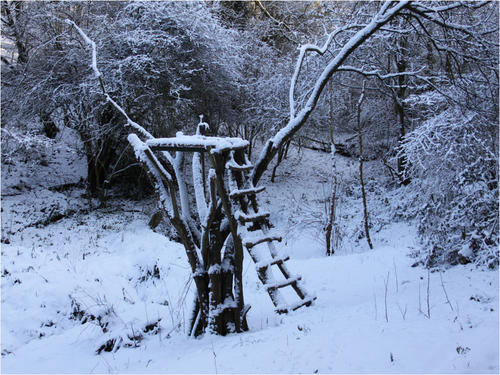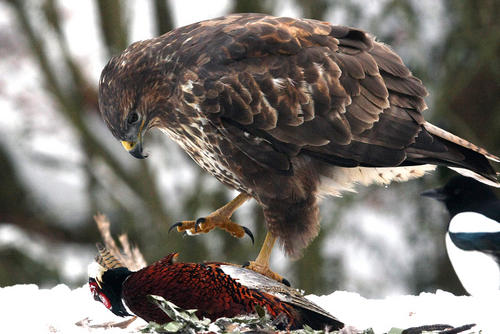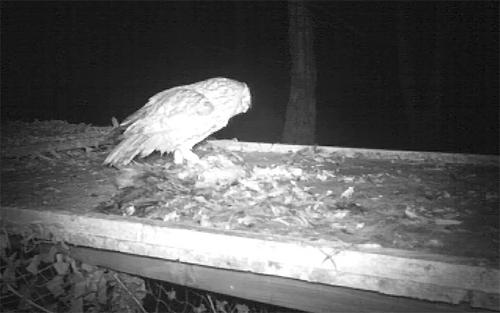Tawny Owl feeding on carrion
Danny Arnold
Chairman - Teme Valley Wildlife Group
Much has been written about our native Owls. Certainly information on the Barn Owl is very well covered in literature, the Tawny Owl, perhaps a little less so. So it was with some surprise that I had the following occur here at Birchfield, my home patch in Upper Rochford, NW Worcestershire. It was an event that was not even on my birding radar.
Some years back, possibly 2008, we took the top out of a sprawling ash tree that was in the valley beside the house. Being in the valley, it was struggling for light, surrounded by trees on the valley sides. As a result of light competition, it had developed many off shoots from the base and was a lanky multi spindled specimen. Where we cut off these tall shoots, some 20 feet up from the base, they acted as supports to hold aloft the 1.5 x 2m platform we put in place, predominantly made out of pallet wood.
(Picture 1)
So for the last few winters, we have, whilst driving around the area on our travels, stopped to pick up fresh (non pan-caked) road kill, comprising mainly of rabbits and pheasants, which we put on the platform for the local Buzzard population to partake of. Over the years, we have had some great photographs of Buzzards coming down to feed and from the markings on the birds, we can tell that the one, probably a female, has been coming down from the very first year we put the platform up. Last year ‘she’ was occasionally joined,by another much smaller ‘male’? bird that has this winter also become a regular visitor to the ‘raptor table’ as it is now known locally. Both birds have very distinctive markings which we have been able to photograph and compare with the luxury of time and a computer.
In the early days, we tried waiting it out in the purpose-made bird hide which we built to overlook the raptor table, but the birds always seemed to know someone was there, however much we camouflaged the openings in the hide. But there was no doubt that the road kill was disappearing whilst we were not about. Eventually we purchased a trail camera, a small battery-driven unit that takes a picture when an infra red detector sensor is triggered. One of the advantages of the trail camera was that we could use it close to the raptor table. It was strapped to the top of a rustic pole secured at the base so it just looked over the platform, twenty or so feet in the air. This unit was triggered by all sorts of things including Robins, Great-spotted Woodpeckers, Great Tits, squirrels and the like, that all used the raptor table to perch on. Eventually we photographed Buzzard coming down and from the record of triggering the unit we found that Buzzards often came down at certain times during the day. This led us to being able to be in the right place at the right time and we soon managed to get some nice DSLR photographs of the Buzzard(s) feeding on the deposited road kill.
(picture 2)
The trail camera is also capable of taking a moderately good quality 30 second video, triggered in the same manner. So over a period of time, we have gained a lot of information about the way in which Buzzards can strip and devour a carcass and indeed, the interaction between two Buzzards after the same meal.
Of late, the trail camera is used mainly to keep an eye on how many different individual Buzzards come down to the table. Once the video clips have been checked, and if there is no ‘new information’ on them, they are now usually deleted, as we have a library full of them.
Right at the beginning of March 2013, we had a real cold snap. The two resident Buzzards had been coming down for road kill during the day for a period of over a week or so. Then on 1st March, the camera triggered on its infra red setting and began to record in complete darkness. With the camera being so close to the platform and automatically changing to the infra red camera setting for night time recording a Tawny Owl was clearly seen, having landed on the raptor table. This had happened occasionally in the past, with the Owl sitting perched there for a while, before taking off. On this occasion however, it walked over to the dead pheasant carcass and began feeding.
(Picture 3)
Initially, it came down and then started to feed for about three minutes, setting the camera off three times (The video duration was set to 30 seconds, with the lapse time set to 15 seconds between triggers). Three hours later it returned, but this time for 30 minutes, triggering the camera consecutively over 20 times (with a couple of very short stays away). It then disappeared for four hours, before coming back for 30 minutes. It then disappeared again for an hour and a half, before making its final visit of the night, which was literally, just one 30 second trigger of the camera.
On the second night, it came down for around 40 consecutive minutes, departed for 40 minutes, then returned intermittently throughout the next 40 minutes.
On the third night, it rained and the camera didn’t trigger at all, presumably because the Owl wasn’t out.
On the fourth night, the Owl came down for a full hour and ten minutes, with one six minute disappearance mid-session. There were no further triggers that night.
On the fifth night, it came down for an hour and five minutes, disappeared for an hour and fifteen minutes before its final return for a fifteen minute feeding session.
It did not come down any of the subsequent 10 nights.
On each occasion, the Tawny Owl is clearly seen tugging at feathers and eating both the feathers and flesh of the carrion. It used its beak to tear the flesh whilst using its feet to hold the carrion down in very much the same manner as the Buzzards. Unlike the Buzzards however, the Owl was much more wary of its surroundings. It would feed for voraciously for ten or fifteen seconds, then just stand still, head turning occasionally, looking around, for similar amounts of time.
It is conjecture as to what was going on, but it would appear firstly that the Owl clearly learnt that food was available at this site and it remembered where the site was, night after night.
At the times of disappearance from the raptor table the Owl was presumably hunting for more usual food like voles, mice and shrews etc? Or was it just resting up in a more secure and less open location, having fed itself on an easy meal? Or was it returning because it had been unsuccessful in finding rodent prey, or because it was just feeling hungry again after gorging itself earlier? All questions we cannot answer. But if we speculate, the cold weather may well have pushed small rodents deep into their burrows below ground, unavailable to owls, so it could well have been a lack of usual food supplies that induced this feeding behaviour. Clearly it was learnt and had become somewhat habitual.
Literature does make reference to Owls taking Carrion in the wild, but it is very scant in detail. I got in touch with several of my contacts in the birding world, but the vast majority had never heard of this behaviour, let alone seen it. This included a quite senior member of the BTO and several very respected RSPB contacts as well as many more local contacts. Most came back with the same few references that I and others had found, but the common theme was that there was very little detail written down about this feeding behaviour. A search of the internet likewise turned up very little information about this subject.
As part of my canvassing for information, I put out a note to our Teme Valley Wildlife Group, to see if any of our members had come across this behaviour before. There were several interesting replies. Of note were two from two different members of the Group in two different parts of the Teme Valley. Both had found a dead, somewhat emaciated, Tawny Owl on their patch that very week. So was this an indication that the Tawny Owls were finding food hard to come by? Several people also reported that they had in times past, ‘spooked’ a Tawny Owl in their head lights from feeding on a dead road kill carcass whilst driving on the county lanes at night. And one other person wrote in to say that she used to keep ducks and on one particular occasion several years back, a small duckling had been dismembered at night. She further wrote, that she had got to know the tell tales signs of a Sparrowhawk kill, but this was something completely different. So the following evening, in a bid to find out if she had a mink or similar problem, she set up a humane trap with a dead pigeon in it. The following morning, she awoke to find the trap triggered, the pigeon pretty much devoured, and a fat and very contented looking Barn Owl sleeping off its dinner. (Which she released unharmed).
So clearly, whilst the documentation is terse, Owls will take dead carrion in the wild and it is possible that this activity is far more common than is actually recorded.
A video clip of this apparently extremely rarely seen behaviour of a Tawny Owl feeding on dead carrion taken here at Birchfield on the raptor table can be seen on the Teme Valley Wildlife Group web site www.temevalleywildlife.com. Scroll down the home page to the 2nd March 2013 and the video link will be found. You will also find some of the Buzzard videos posted above it on the 4th March.
Reference
Cramp, S (ed) 1985 The birds of the Western Palearctic. Volume 4. Oxford University Press. Section Strix aluco Tawny Owl, page 529 referring to food.
Image
Fig.1.The Raptor table. Danny Arnold
Fig. 2. Buzzard feeding on road-kill on the raptor table. Danny Arnold.
Fig.3. Tawny Owl feeding on road-kill on the raptor table at night. Danny Arnold


